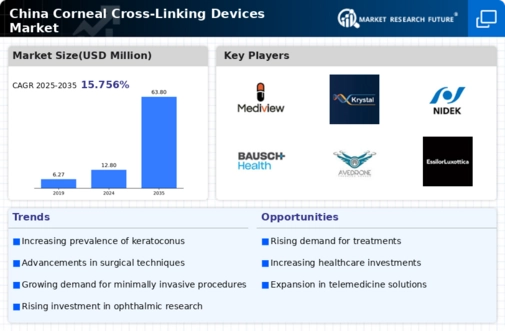Growing Aging Population
The demographic shift towards an aging population in China is a crucial driver for the corneal cross-linking-devices market. As individuals age, the prevalence of eye-related conditions, including keratoconus and other corneal diseases, tends to rise. This demographic trend is expected to lead to a higher demand for effective treatment options, including corneal cross-linking procedures. With the elderly population projected to reach 400 million by 2035, the market is likely to see a significant uptick in patients seeking these treatments. Consequently, healthcare providers are increasingly investing in corneal cross-linking devices to meet this growing demand, which may result in a market growth rate of approximately 18% in the coming years.
Rising Prevalence of Keratoconus
The increasing incidence of keratoconus in China is a pivotal driver for the corneal cross-linking-devices market. Recent studies indicate that keratoconus affects approximately 1 in 500 individuals in the country, leading to a growing demand for effective treatment options. As awareness of this condition rises, more patients seek interventions that can halt disease progression. The corneal cross-linking procedure has emerged as a preferred treatment, as it strengthens corneal tissue and improves visual acuity. This trend is likely to propel the market forward, with projections suggesting a compound annual growth rate (CAGR) of around 15% over the next five years. The increasing number of specialized clinics and hospitals offering this treatment further supports market growth.
Government Initiatives and Support
Government initiatives aimed at improving eye care services in China are fostering growth in the corneal cross-linking-devices market. The Chinese government has implemented various health policies to enhance access to advanced medical treatments, including corneal cross-linking. These initiatives often include funding for research and development, as well as subsidies for healthcare facilities to acquire state-of-the-art equipment. As a result, the market is likely to experience increased investment, with projections suggesting a potential market value increase of 30% over the next five years. This supportive environment encourages the adoption of corneal cross-linking technologies, ultimately benefiting patients and healthcare providers alike.
Technological Innovations in Treatment
Technological advancements in corneal cross-linking devices are significantly influencing the market landscape in China. Innovations such as the development of faster and more efficient devices, including those utilizing ultraviolet light and riboflavin solutions, enhance treatment efficacy and patient comfort. These advancements not only improve procedural outcomes but also reduce recovery times, making the treatment more appealing to patients. The introduction of new devices is expected to capture a larger market share, with estimates indicating that the segment could grow by 20% in the coming years. As healthcare providers adopt these cutting-edge technologies, the corneal cross-linking-devices market is poised for substantial expansion.
Increased Investment in Healthcare Infrastructure
The expansion of healthcare infrastructure in China is a vital driver for the corneal cross-linking-devices market. As the country continues to invest in modernizing its healthcare facilities, there is a corresponding increase in the availability of advanced medical technologies, including corneal cross-linking devices. This investment is particularly evident in urban areas, where specialized eye care centers are emerging. The establishment of these centers not only enhances access to treatment but also promotes awareness of corneal diseases and available interventions. Market analysts predict that this trend could lead to a 25% increase in the adoption of corneal cross-linking devices over the next few years, as more patients gain access to these essential services.



















Leave a Comment